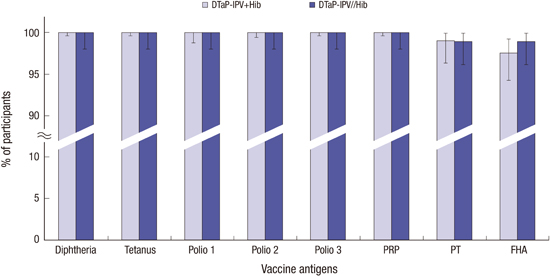2. Vidor E, Plotkin SA. Immunogenicity of a two-component (PT & FHA) acellular pertussis vaccine in various combinations. Hum Vaccin. 2008; 4:328–340.
3. Plotkin SA, Liese J, Madhi SA, Ortiz EA. DTaP-IPV//PRP~T vaccine (Pentaxim): a review of 16 years' clinical experience. Expert Rev Vaccines. 2011; 10:981–1005.
4. Eskola J, Ward J, Dagan R, Goldblatt D, Zepp F, Siegrist CA. Combined vaccination of Haemophilus influenzae type b conjugate and diphtheria-tetanus-pertussis containing acellular pertussis. Lancet. 1999; 354:2063–2068.
5. Collins S, Ramsay M, Campbell H, Slack MP, Ladhani SN. Invasive Haemophilus influenzae type b disease in England and Wales: who is at risk after 2 decades of routine childhood vaccination? Clin Infect Dis. 2013; 57:1715–1721.
6. World Health Organization. WHO position paper on Haemophilus influenzae type b vaccines. Wkly Epidemiol Rec. 2006; 81:444–452.
7. Newcombe RG. Two-sided confidence intervals for the single proportion: comparison of seven methods. Stat Med. 1998; 17:857–872.
8. Newcombe RG. Interval estimation for the difference between independent proportions: comparison of eleven methods. Stat Med. 1998; 17:873–890.
9. Lee H, Hahn S, Lee HJ, Kim KH. Immunogenicity of Haemophilus influenzae type b conjugate vaccines in Korean infants: a meta-analysis. J Korean Med Sci. 2010; 25:90–96.
10. Käyhty H, Peltola H, Karanko V, Mäkelä PH. The protective level of serum antibodies to the capsular polysaccharide of Haemophilus influenzae type b. J Infect Dis. 1983; 147:1100.
11. Cherry JD. Update on pertussis and diphtheria-tetanus toxoids-pertussis vaccination new strategies for clinicians. Introduction. Pediatr Infect Dis J. 1997; 16:S76–7.
12. Greco D, Salmaso S, Mastrantonio P, Giuliano M, Tozzi AE, Anemona A. A controlled trial of two acellular vaccines and one whole-cell vaccine against pertussis. Progetto Pertosse Working Group. N Engl J Med. 1996; 334:341–348.
13. Gustafsson L, Hallander HO, Olin P, Reizenstein E, Storsaeter J. A controlled trial of a two-component acellular, a five-component acellular, and a whole-cell pertussis vaccine. N Engl J Med. 1996; 334:349–355.
14. Gzyl A, Augustynowicz E, Rabczenko D, Gniadek G, Ślusarczyk J. Potency of pertussis component in the DTP vaccine--an overview of three decade study in Poland. Biologicals. 2004; 32:129–137.
15. Thollot F, Scheifele D, Pankow-Culot H, Cheuvart B, Leyssen M, Ulianov L, Miller JM. A randomized study to evaluate the immunogenicity and safety of a heptavalent diphtheria, tetanus, pertussis, hepatitis B, poliomyelitis, Haemophilus influenzae b, and meningococcal serogroup C combination vaccine administered to infants at 2, 4 and 12 months of age. Pediatr Infect Dis J. 2014; 33:1246–1254.
16. Kim JS, Cho SB, Lee HR, Park SK, Hwang PH. Immunogenicity and safety of Haemophilus influenzae type b polysaccharide-tetanus toxoid conjugate vaccine (PRP-T) in Korean infants. Korean J Infect Dis. 1996; 28:225–232.
17. Lee SY, Hwang HS, Kim JH, Kim HH, Lee HS, Chung EH, Park SE, Ma SH, Chang JK, Guitton F, et al. Immunogenicity and safety of a combined diphtheria, tetanus, acellular pertussis, and inactivated poliovirus vaccine (DTaP-IPV) compared to separate administration of standalone DTaP and IPV vaccines: a randomized, controlled study in infants in the Republic of Korea. Vaccine. 2011; 29:1551–1557.
18. Peltola H, Aavitsland P, Hansen KG, Jónsdóttir KE, Nøkleby H, Romanus V. Perspective: a five-country analysis of the impact of four different Haemophilus influenzae type b conjugates and vaccination strategies in Scandinavia. J Infect Dis. 1999; 179:223–229.
19. Georges S, Lepoutre A, Dabernat H, Levy-Bruhl D. Impact of Haemophilus influenzae type b vaccination on the incidence of invasive Haemophilus influenzae disease in France, 15 years after its introduction. Epidemiol Infect. 2013; 141:1787–1796.
20. Kim KH, Kim YK, Kim NH, Chang SH, Lee J, Park EA, Park SE, Eun BW, Lee H, Lee HJ. Immunogenicity and safety of LBVH0101, a new Haemophilus influenzae type b tetanus toxoid conjugate vaccine, compared with Hiberix™ in Korean infants and children: a randomized trial. Vaccine. 2012; 30:1886–1894.
21. Bedford H, Lansley M. More vaccines for children? Parents' views. Vaccine. 2007; 25:7818–7823.
22. Wallace AS, Mantel C, Mayers G, Mansoor O, Gindler JS, Hyde TB. Experiences with provider and parental attitudes and practices regarding the administration of multiple injections during infant vaccination visits: lessons for vaccine introduction. Vaccine. 2014; 32:5301–5310.









 PDF
PDF ePub
ePub Citation
Citation Print
Print






 XML Download
XML Download